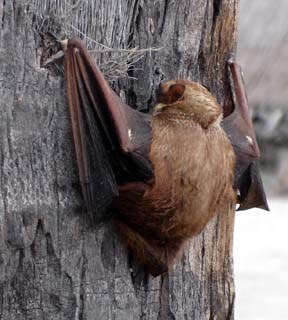
Kimberly Krusell-NPS Photo ʻŌpe'ape'a (Hawaiian Hoary Bat) Just after sunset is the most common time to observe the ʻōpeʻapeʻa. The endangered ʻōpeʻapeʻa is the only land mammal native to Hawai'i. It appears to be a solitary bat that roosts in trees and feeds on insects. The name 'hoary' means ghost-like, and thus named due to the frosted tips of the ʻōpeʻapeʻa fur. Much is unknown about this species but current monitoring in the park by USGS will hopefully provide information about diet, habitats and behavior.
ʻIlio-holo-i-ka-uaua (Hawaiian Monk Seal) ʻIlio-holo-i-ka-uaua (monachus schauinslandi), is an endangered marine mammal that is endemic to the warm, clear waters of the Hawaiian Islands. Scientist estimate about 1,000 to 1,200 monk seals live in this archipelagoe today. The species has declined at approximately 4% per year since 1989 and is the most endangered U.S. marine mammal. It is uncommon to spot a monk seal near the shores of Puʻuhonua o Hōnaunau NHP. Any sighting should be reported to a park ranger. |
|
Aquatic Mammals Although the na koholā are the most commonly observed ocean mammals, other species may also be seen in the Hawaiian waters. From the shores, watch for a visible, uprising vapor just above the water, that is created when a whale surfaces for air and exhales through its blow hole. Nai'a is the Hawaiian name for dolphin. The aerial acrobats of the Spinner dolphins are commonly seen across the bay from the Puʻuhonua shores. They leap out of the water and spin laterally through the air before the body and tail once again disappears into the ocean.
The mongoose was introduce from India to help reduce the rat population, which was a particular nuisance to the sugarcane industry. Unfortunately, the mongoose has become the textbook example of a failed biocontrol effort. The rat is nocturnal and the mongoose is diurnal and seldomly meet. Although the mongoose did little to change the rat population it is a major contributor to the decline of native ground nesting birds. Mammal Species Observed in the ParkGet a list of mammals found at Puʻuhonua o Hōnaunau National Historical Park. Select "Mammals" in the drop down menu below. Select a Park:Select a Species Category (optional):
Search results will be displayed here.
|
Last updated: July 16, 2020
